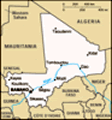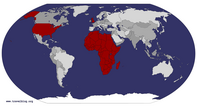Advertisement
Published: April 27th 2009
In the morning we woke up for breakfast and met up with Souleman to head to the Dogon country. We took a horse cart which literally was a horse pulling a flat piece of wood on wheels that we all sat on. As we were driving out of Bankass and through other villages little kids would run out of their houses screaming and waving at us as we were driving. I felt like we were in some sort of parade. It took us about 2 hours to get from Bankass to the first village Kani-Kombole.
So Souleman was our guide and he is Dogon, so that was nice because he knows the traditions and the religious aspects of Dogon life, plus he knows the language which is extremely important. He mainly speaks Dogon and French, but he knows quite a bit of English from being a tour guide. He suffers from polio and walks with a cane, but this in no way hindered our tour or hiking. I was really surprised by how quickly he could scale the mountain and often found myself scrambling after him. The Dogon country is this mountain that plateaus and thousands of years ago the
Dogon built villages into the mountain. As the water level lowered and eventually disappeared the Dogon moved further down the mountain and now live in villages at the bottom of the mountain. Its one of the few places left in West Africa that for the most part is untouched by modern technology. Its as close to traditional village life as you can get. This means there’s obviously no electicity, running water, or even contemporary buildings. All of their buildings are built from mud bricks that they make themselves and then covered with more mud. They have flat roofs and for some reason really reminded me of the village in Aladdin. Each village does have a traditional mosque that is built in the Sudanese mud fashion and that is about as contemporary as they get. The only reason they have seen white people is because of tourists like us that they so kindly let in (only with a guide of course!)
After we arrived in Kani-Kombole we set our stuff down at the compound where we later ate lunch and filled up with some water and went off into the village. There aren’t streets because there isn’t any need for
them, so it’s a bunch of building that have an ally between them and it forms some sort of maze. As you’re walking through the maze you’ll randomly run into a group of women hanging out and preparing food, or some kids playing, or my favorite, donkeys and cows in stables that looked like reenactments of Jerusalem at Christmas time. Everyone was really friendly and would smile and say hello, and then just went about their daily business. We found men making rope or horse carts and had a nice posse of kids following us through town. The kids were a lot of fun and I really enjoyed playing with them. One little boy and his brother followed us the entire time and practically latched on to me. Whenever another kid would try to hold my hand they would push them out their way as if they claimed me. We walked up onto the mountain and walked through some of the ruins of the former villages that are built into the mountain. It was so crazy to me that we were allowed to be climbing around in these historic ruins and be walking through buildings that were thousands of years
old. You could just feel all the history there. The mosque was really interesting, but we aren’t allowed to go inside. They did allow us to take pictures of the mosque, but not of any of the men praying outside. It’s the best looking building in town because every year after the rainy season they repair the mud walls that have eroded away from the rain and it always looks brand new.
We went back to the compound where we ate lunch of macaroni in a tomato sauce and grilled chicken and hung out for a few hours trying to stay out of the heat. I just couldn’t believe the heat here. I know were in Africa, and were in the desert, its going to be hot, but it was just insane. I really don’t even want to know the actual temperature. It’s a dry heat, so when you sweat it just dries instantly before it can cool you off.
Around 2:30 or 3 the action in town got started. It was market day and everyone in the village came out. Market day is just as much about getting dressed up and socializing as it is about taking
care of the weekly shopping. Looking out at the market from the roof of the compound was spectacular. The bright colors of the women’s clothes bustling around against the background of the burnt orange desert sand was one of the most beautiful things I have seen. We decided to go down and join the market scene. As we were walking down the youngest boy from earlier in the village (he was probably 4?) spotted me and came running over (this time he was actually wearing clothes!) and gave me a big hug. He walked me through the market holding my hand where he would pull me to where some of his friends were, would make me shake their hands, and before I was finished would grab me and pull me to another group of friends. As I got to know the market a little better, I found a table with a boy selling balloons for 10 cefas (about a penny) and bought one for my little tour guide. While the market was happening, a bunch of motorbikes came rushing into the village honking their horns and people were cheering and doing tricks on them. There was quite a commotion and
other 4x4s with people hanging out the window cheering. Everyone in the market rushed over and they were cheering as the caravan was handing out t-shirts and hats. We found out later that the elections in Mali were in a week and these people were with one of the candidates trying to get votes.
The rest of the afternoon we spent in the compound escaping the heat and playing rummy until it cooled down a bit and we would walk to the next village, Teli. Around 4:30 we walked the 3 km to Teli which was a smaller village, but had a much larger old village up in the mountain that we were going to look at in the morning. It quickly got dark and we had our dinner and went to bed around 9.
The next morning we woke up at 6:30 to the sunrise and the sounds of the village waking up. Rosters crowing, donkeys making their awful noises, and women taking care of the morning cleaning. I slept pretty well, but apparently Max was up all night from food poisoning. The only thing we can think of was that he tried some of the millet dough
that some of the men in the last village were eating the day before but we were all too distracted by the children to join him. It had to be what made him sick because it was the only thing he ate and we didn’t. Thank goodness for those little kids then! For breakfast we ate these millet cakes that were the shape and fluffiness of pancakes, but were greasy and tasted more like corn. They tasted very similar to Mexican corn tortillas and then we dipped them in sugar.
We walked through the town of Teli and went up into the mountain at the old village. It was much more elaborate than the one the day before and we could see the differences between buildings. There were houses, and then these areas reserved for the elders in the village to discuss important matters, almost like the village courthouse. Then we saw the Hogon hut, which is the chief of the Dogon village. His building is much more elaborate with a more decorative door and painted walls with various patterns and shapes. We spent a little longer here today because there was a lot more to see, but then
we headed back down and took a horse cart to Ende.
Ende is another village and is the village where Souleman is from. We hung out here and toured the town as well. In the town there is a little area where people sell their crafts and I bought some jewelry and mud cloth. The mud cloth was really cool here because it’s a very African thing that I’ve seen a lot, but usually its really expensive and I haven’t been able to justify spending that much for it. Here its really cheap and they actually make it there. We watched the boys and men paint the clothe with paint that is literally made with mud. They showed us the process and it was interesting. I also bought a turban here which was really funny. It turned into quite an attraction by the end of the trip once someone taught me how to tie it. The rest of the group made fun of me, but by the time we got to Timbuktu a few days later and they couldn’t breath because of all the dust and I was fine they weren’t laughing and actually bought one too!
Anyways, back on
track, we went back to the compound in Teli and ate lunch and waited for it to cool down again during the heat of the day before we took a horse cart back to Bankass where we slept at the same great hotel on the roof for another night.
Advertisement
Tot: 0.105s; Tpl: 0.012s; cc: 16; qc: 65; dbt: 0.0449s; 1; m:domysql w:travelblog (10.17.0.13); sld: 1;
; mem: 1.2mb














